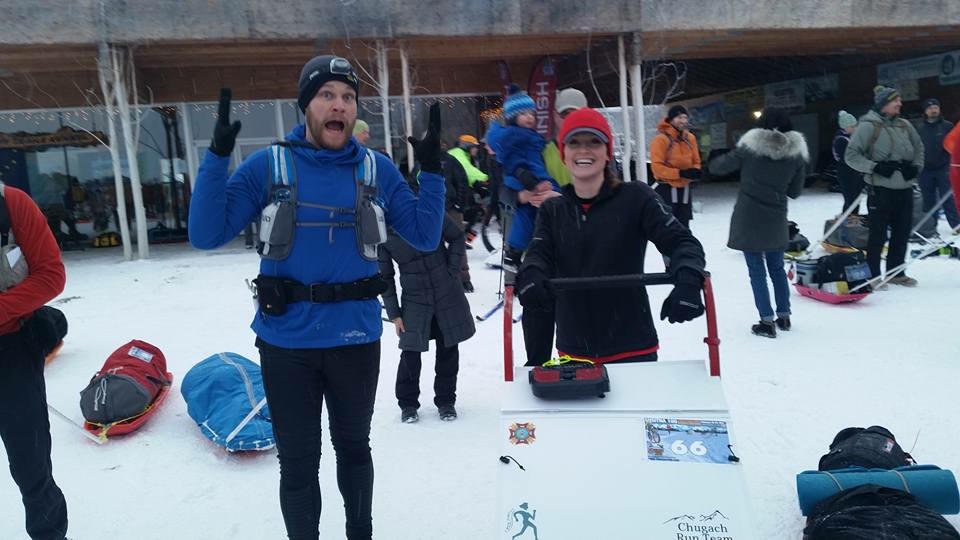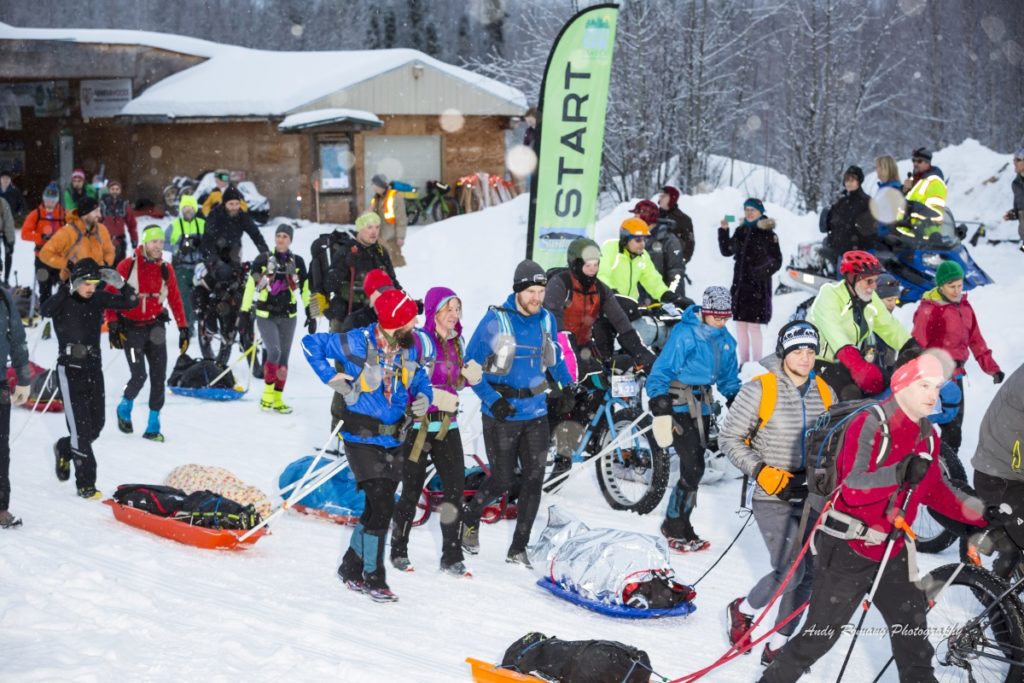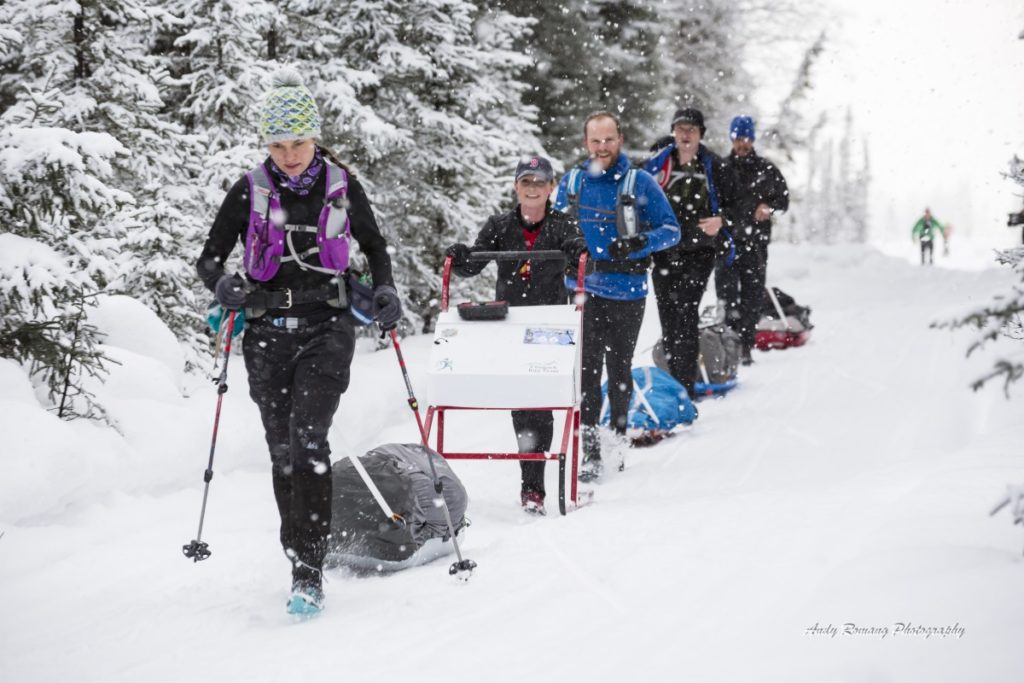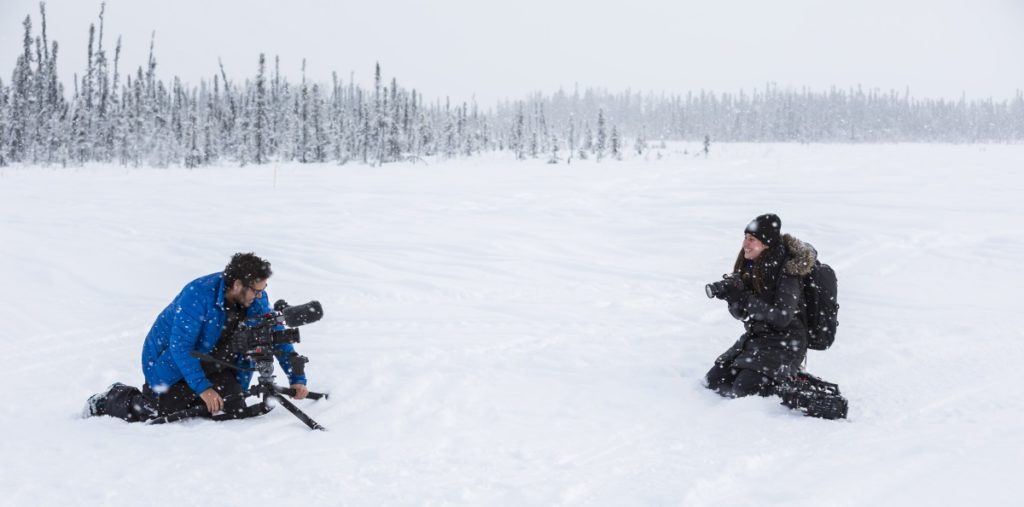After much preparation and stressing over gear choices and my sled, the Susitna 100 finally arrived. As if running 100 miles in the middle of the Alaskan winter wasn’t going to be hard enough on its’ own, it turned out that I was also going to have a CNN film crew following me!

Let me take a few steps back and explain that last part. Around the end of January, the race directors were contacted by CNN. They wanted to do a story on the race for their Fit Nation series, and were looking for suggestions for someone “interesting” to profile and follow during the race. They gave them several names, and after a preliminary interview, I found out that they had picked me! They flew up to Alaska from New York the week of the race, and I spent several hours with them over a couple of days recording interviews, getting shots of family time at my house, and doing some “Hollywood running” around my neighborhood and on nearby trails. They planned to follow me as much as possible during the race (only 2 of the 6 checkpoints are accessible by road), and they also gave me a small video camera similar to a GoPro to take some of my own footage during the race.
Ok, now back to the race. Thursday night was gear check, where they made sure we had all the required gear, and a minimum of 15 pounds (not including our sleds!). Then we got a brief trail report from the race director. He reported that area had not seen as much recent snow as we had in Anchorage (yay!), but that it had been warm, leading to soft, punchy trails (boo!). The forecast called for temps to cool down into the 20s by the weekend, so we were all hopeful that would make for nicely packed trails on race day.
Fast-forward to race morning, and some parts of the course had seen as much as 5-6″ of fresh snow overnight, and the temps were still warm (high 20s/low 30s). Waiting for the race to start at 9am, I think we were all a bit apprehensive. Nearly 100 bikers, 28 runners, and 10(-ish) skiers stood in waiting for the long journey ahead. Promptly at 9am, the race directory yelled “GO!”, and we all set off into the frozen Alaskan wilderness.


Leading up to this race, I had a much higher level of stress and anxiety than I’ve had for a race in a long time. I’m sure it was a mixture of it being a new race, in winter, with all that gear to pull in a sled, plus being followed by a CNN crew. But as soon as the race started, all of that immediately melted away, and I just ran. Sure, the cameras were there at the start, and there was a drone following me the first bit, but once all the planning and prep was done, and I was finally out there running, none of those other things seemed to matter anymore.

My cousin Sarah was also running this race, and our plan was to run the entire thing together. That’s a long time to be out there alone, and a lot of things can go wrong. Sarah went a somewhat unconventional route with her sled design – her husband fabricated a push sled for her, and it looked amazing. She got a lot of attention over that at the starting line. She has a toddler, and is used to pushing a jogging stroller, so her theory was that something like this would work better for her.

The first checkpoint wasn’t until mile 22, the longest stretch of the race between checkpoints. Still fresh, this section went by relatively well for us. Though there were a few steep hills that we both had difficulty with pushing/pulling our sleds up. Then, around mile 15, we hit a bad patch of overflow on one of the frozen swamps. We did our best to pick a path through it, but still ended up with soaking wet feet by the end of it. I had a spare pair of shoes with me, but didn’t want to change them so early in the race, in case we hit more overflow later. Finally, we popped out of the trails onto a road, and we knew the first checkpoint couldn’t be far. The CNN crew was waiting for us, and drove along the entire section of road filming us until the checkpoint (probably 1-2 miles total). I was fairly tired by this point from pushing through all the fresh snow, but I tried running as much as I could, trying to “look good for TV” 🙂


When we reached the first checkpoint, they tell us that they’ve run out of water, but that more is coming. Instead I grab a Coke and some peanut M&Ms, and start reloading food into my vest from my sled for the next section. It’s only 12 miles to the next checkpoint at Flathorn Lake, and I still had a decent amount of water, so I was about ready to leave, when more water arrived. I quickly refilled my hydration bladder, and then we were hitting the trail again. There was only a short section of road left that the camera crew could follow me, although that didn’t stop them from sending the drone after me for another 1/2 mile or so. The next road-accessible checkpoint wasn’t until mile 63 at Eagle Quest Lodge, so I knew it would be a while before I would see them again.
On our way to Flathorn Lake, we were getting fairly tired from the poor trail conditions, and there was a decent amount of walking involved. It was beginning to get dark, so we put on our headlamps and settled in for the 14 hours of darkness ahead. It had been snowing a good amount all day, and as we approached the lake, the trail conditions seemed to worsen. It was looking like it could be a long, slow night. As promised, there was a Christmas tree lit up near the checkpoint, that we could see from far away, welcoming us to the next checkpoint. As we arrived, there were several other sleds already there. A full spread of food awaited us inside, including a spaghetti dinner with bread, and plenty of cookies, brownies, and other snacks.

We quickly filled our bellies and were on our way again, this time with 14 miles to go until the next checkpoint at 5 Star Tent, along the Susitna River. At this point, quite by accident, we were travelling in close proximity to 5 or 6 other racers. Travelling along the Susitna River at night, we could see for long stretches in either direction, and spot the lights of multiple headlamps bobbing up and down in the night. There is a certain comfort in knowing that even though we’re pretty much out in the middle of nowhere, we’re not really alone out there. By the time we reached 5 Star Tent, the snow was coming down pretty hard. As we approached the checkpoint, the combination of the snow, the way the tent was lit up in the night, and my own sleep deprived mind, it looked to me like the tent was enormous. I’m thinking to myself “why would they haul such a gigantic tent out here in the middle of nowhere?” It wasn’t until I stepped into the tent that I realized it was only about 12 x 12 feet.
It was nice and warm inside, and they were serving some hearty beef stew with buttered rolls. I drank some coffee to help wake me up a bit. I also changed my socks at this point (still holding out on changing my shoes). I looked over and Sarah was curled up in a chair with her eyes closed. Not quite asleep yet, I asked if she was ready to head back out. We found our sleds had already accumulated a decent amount of snow, which was still falling down hard in large flakes.
Another 15 miles to go until the next checkpoint at Eagle Quest Lodge, where we could buy a hot meal, and lay down in one of the cabins if we needed some sleep. Unfortunately Sarah was already getting quite sleepy, and starting to slow down. She kept telling me to go ahead without her if I felt strong, but I was very hesitant to leave her in the middle of the night. This went on for several miles, and then she began to worry about making both of us miss the next cutoff, and practically insisted that I leave her. With much hesitation, I pushed on without her. Surprisingly, I was actually feeling pretty good at this point, and started moving along at a decent pace. Before I knew it, I was all by myself. I turned back and could no longer see headlamps bouncing in the night. Finally, the trail turned to the right, taking me up off the river. A few miles later, I found myself pulling into Eagle Quest Lodge, around 6:30 in the morning.
I ended up beating the CNN crew to the checkpoint. The race rents out all the cabins at Eagle Quest for the weekend for the racers to use, and the next closest place for them to stay the night was 35 miles away. When I went inside, there was quite a bit of carnage to be found. A good number of racers were there, getting some warm food in their bellies and nursing their wounds. There were many long, tired faces. Many were either already sleeping, or planning to take a nap there. Several runners I knew were inside the lodge, and they were all walking around barefoot, trying to dry out their soaked and blistered feet. I soon joined them, taking off my thoroughly drenched socks and shoes. About this time the CNN crew arrived, and began filming my hideous feet 🙂
All in all, I was actually feeling pretty good. The sleepiness I had in the middle of the night had passed. As good as a hot meal sounded, I wanted to get out of there and continue pushing on as soon as I could. I ordered some coffee and a muffin, and a gigantic chocolate brownie that I took for the road. I popped and drained a few blisters, and changed into some dry socks and (finally) my spare pair of shoes. I headed back outside and got strapped back up to my sled. Before heading out, the CNN crew did a quick interview with me on how I was feeling so far and how things had been going. Just before I left, Sarah pulled into the checkpoint. I chatted with her briefly – she seemed in decent spirits, but was very tired and planned to take a nap before heading out again. The CNN crew followed me on foot a short ways down the trail as I headed towards the next checkpoint at Cow Lake, 17 miles away.
This ended up being a very long, lonely section of the race for me. I passed 2 other runners within the first couple of miles, but then quickly found myself alone. There are many long miles across the frozen Willow swamp area. There was a very flat light at this point due to it being overcast, which makes the snowy terrain almost featureless. This makes it very difficult to follow the “good” part of the trail. Luckily it had stopped snowing by then, and there was at least a relatively good, packed part of the trail to follow. It was just hard to find in the flat light. My mind was also starting to play tricks with me. Many times, I was sure I saw another racer up ahead, but every time as I approached, it turned out to be a tree. In fact, I wouldn’t see another person until I finally arrived at Cow Lake. Just before I came into the checkpoint, I saw 3 others leave. When I stepped into the tent at the checkpoint, there was one other runner already inside.

I soon learned that aside from these 4 runners, there was only 1 other ahead of me. This caught me by surprise and got me excited, as I’m normally nowhere near the front of the pack. I made quick work of refueling and filling my pack, and getting back out on the trail. I left the checkpoint with the runner who was already there when I first arrived. He was a friendly guy from Oregon named Tom. We made our way across the lake together, only to find the 3 who had left ahead of us waiting at the other end. Snow machine racers in the Iron Dog were coming through a narrow section of trail where we needed to go, whizzing past at 50-60 mph. It wasn’t worth the risk, so we waited probably 20-30 minutes until the rest of the teams had made it through. We were at mile 80 of the race, and some of the others were looking pretty tired and out of it at this point. Somehow, I was feeling pretty buzzed and full of energy. Once we got moving again, I took off and was quickly out of sight of the other 4. Very unexpectedly, I had found myself in 2nd place.
I only had 10 miles to go until the last checkpoint at mile 90. I did my best to keep moving as quickly as I could, doing as much running as possible. Anytime there was a longer straight section, I would turn back and look to see if I could spot anyone behind me, but I never did. Still, I didn’t want to risk anything, so I kept pushing ahead. I knew I was getting close to the checkpoint, and was still feeling pretty good, so I planned to get in and out as quickly as possible.

Pulling into that final checkpoint, the CNN crew was there waiting for me, having gotten a ride in on snow machines. At the checkpoint, I asked what they had with caffeine, and took a Coke to go. I only chatted with the CNN crew for a brief moment, and then I was back on the trail. Of course they weren’t done with me yet – they hopped on the snow machines and followed me for a while down the trail, first filming from behind me, and then pulling around and filming from in front. Then they took off, wishing me luck, and leaving me to my thoughts for the final 9 miles of this adventure.
I felt fairly confident at this point that nobody was going to catch up to me. I also knew that the one person ahead of me was quite speedy, and had likely already finished, so there was no need for me to hurry too much. I spent time thinking about the long journey behind me, and about my cousin who I had parted ways with many miles ago. I hoped that she was feeling better, and that she was still moving. The sun was starting to set again, and it was beginning to get dark. I knew I was only a few miles from the end, so I hoped I would finish before it truly got dark again. From about 2 miles out, you can start to see the finish up on a distant hillside, teasing you. I knew I was close now. Soon, I was running up the final insult of a hill, just before the finish line. Then, I was done. It had taken me 33 hours and 18 minutes, more than 5 hours longer than I’ve ever been out on a race course before.
The CNN crew was there, of course, and I gave them some final thoughts and a parting interview after finishing. Sadly, the roads were really bad so my wife didn’t want to make the 90 mile drive with the kids. Instead, my dad was there to see me finish and drive me home. I quickly got on the phone with my wife to tell her I was done and that I’d finished in 2nd place. She told me that my cousin Sarah had ended up dropping back at Eagle Quest. She had been throwing up and lost 10 pounds, and decided it wasn’t smart to push on. After changing into some regular (and dry!) clothes, I was on my way home, and quickly passed out in my dad’s truck, having been awake for about 37 hours straight at that point.


Overall I had a really great experience at this race. The CNN crew was really nice and a lot of fun to work with, and I can’t wait to see how the story turns out. I’ll definitely post a link once it’s online. Despite the tough conditions – this was by far the most difficult race I’ve completed to date – the race directors did an amazing job of putting on a really fun race, and I’m already thinking about next year!
In closing, I want to give a quick shout out to Altra and Injinji for keeping my feet (mostly) happy in these brutal conditions. Especially considering that my feet were wet and cold most of the race, they seemed to fare better than most. I went through 2 pairs of Altra Lone Peak NeoShells, and 3 pairs of Injinji socks during the race. There is no way that I could do these kinds of races without great gear backing me up.

[…] Susitna 100 Race Report – Brandon Wood […]